Recent Progress in Low-Power-Consumption Metal Oxide Semiconductor Gas Sensors
Abstract
1. Introduction
2. Room-Temperature Gas Sensors
2.1. Room-Temperature CO Sensors
2.2. Room-Temperature NO2 Sensor
2.3. Room-Temperature H2 Sensor
2.4. Room-Temperature CH4 Sensor
3. MEMS Gas Sensor
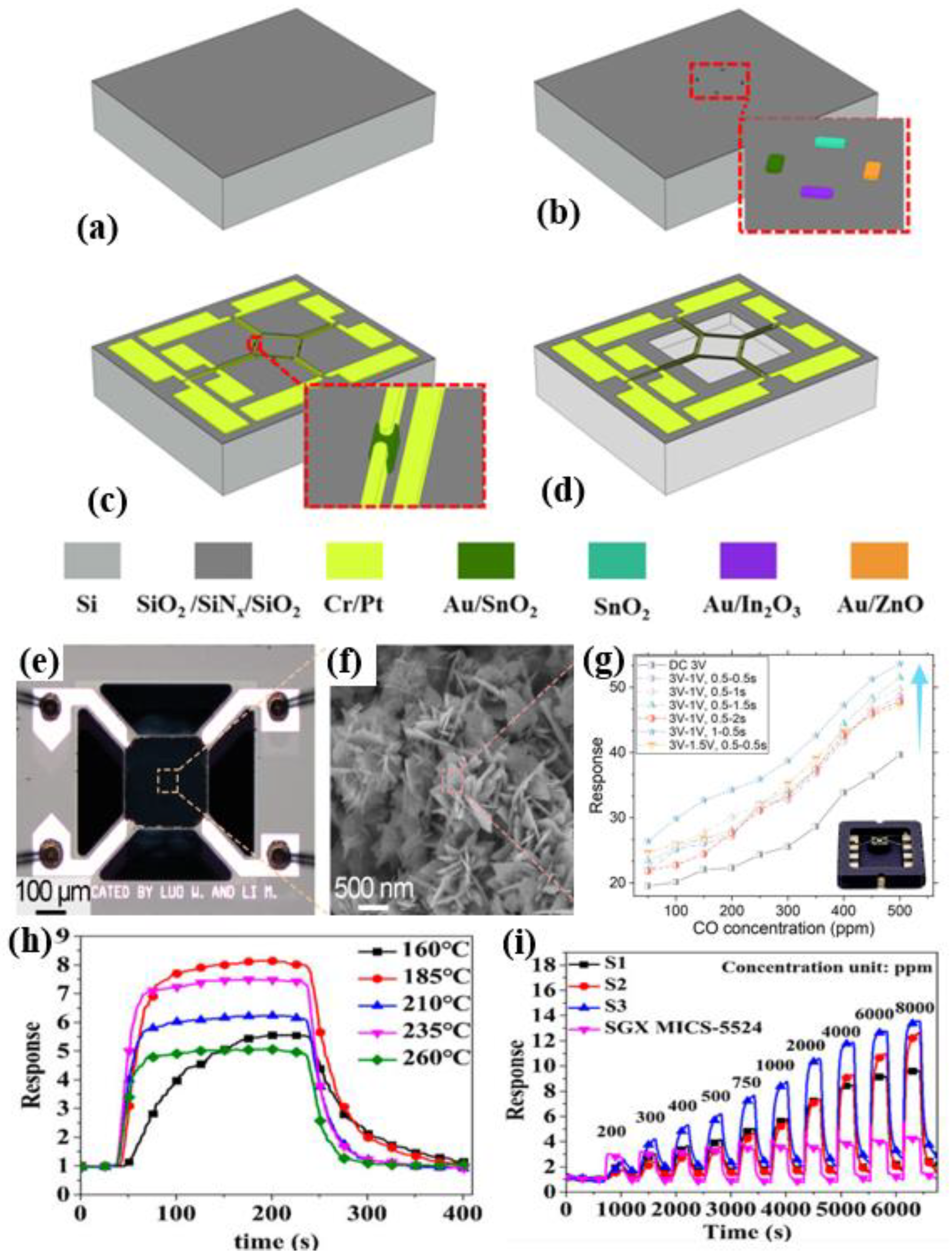
3.1. Research Progress of MEMS Micro Hotplate
3.2. MEMS MOS Sensors Based on Various Sensitive Materials
3.2.1. MEMS MOS CO Sensors
| Sensing Material | Working Temperature (°C) | Conc. (ppm) | Response Value (Rg/Ra or Ra/Rg) | Response/ Recovery Time (s) | Reference |
|---|---|---|---|---|---|
| 10 wt%WO3/0.5 wt%Pt/SnO2 NS | 400 | 20 | 1.31 | 91/134 | [76] |
| Ag/Pd/Ru/SnO2 | 200 | 50 | 1.67 | -/- | [77] |
| Al doped TiO2 | 400 | 200 | 2.22 | -/- | [78] |
| Pd/SnO2 nanopowder | 300 | 60 | 0.23 | -/- | [75] |
3.2.2. MEMS MOS NO2 Sensors
3.2.3. MEMS MOS H2 Sensors
3.2.4. MEMS MOS CH4 Sensors
4. Challenges and Prospects
5. Conclusions
Author Contributions
Funding
Data Availability Statement
Conflicts of Interest
References
- Gao, D.H.; Yu, Q.C.; Kebeded, M.A.; Zhuang, Y.Y.; Huang, S.; Jiao, M.Z.; He, X.J. Advances in Modification of Metal and Noble Metal Nanomaterials for Metal Oxide Gas Sensors: A Review. Rare Met. 2025, 44, 1443–1496. [Google Scholar] [CrossRef]
- Shooshtari, M.; Vollebregt, S.; Vaseghi, Y.; Rajati, M.; Pahlavan, S. The Sensitivity Enhancement of TiO2-Based VOCs Sensor Decorated by Gold at Room Temperature. Nanotechnology 2023, 34, 255501. [Google Scholar] [CrossRef]
- Shooshtari, M.; Salehi, A. An Electronic Nose Based on Carbon Nanotube -Titanium Dioxide Hybrid Nanostructures for Detection and Discrimination of Volatile Organic Compounds. Sens. Actuators B Chem. 2022, 357, 131418. [Google Scholar] [CrossRef]
- Jiao, M.; Zhao, X.; He, X.; Wang, G.; Zhang, W.; Rong, Q.; Nguyen, D.H. High-Performance MEMS Oxygen Sensors Based on Au/TiO2 Films. Chemosensors 2023, 11, 476. [Google Scholar] [CrossRef]
- He, Y.; Jiao, M. A Mini-Review on Metal Oxide Semiconductor Gas Sensors for Carbon Monoxide Detection at Room Temperature. Chemosensors 2024, 12, 55. [Google Scholar] [CrossRef]
- Zhu, L.; Wang, H.; Qiu, C.; Li, M.; Li, Q.; An, F.; Song, Y.; Wang, T.; Jiao, G.; Ding, Z.; et al. Carbon Monoxide Gas Sensor Based on Hydrothermally Synthesized Pd-CuO Nanorods/SnSe2 Nanoflower Heterojunctions. ACS Appl. Nano Mater. J. 2024, 7, 25847–25856. [Google Scholar] [CrossRef]
- Song, J.; Zhao, J.; Wu, M.; Hu, Y.; Chen, W. Greatly Improved Room-Temperature CO-Sensing Capability of Pt–SnO2 Composite Nanoceramics Prepared Using Solution Reduction Pt-Loading Method. J. Mater. Sci. Mater. Electron. 2025, 36, 223. [Google Scholar] [CrossRef]
- Liu, L.; Zhao, J.; Li, S.; Liu, F.; Jin, Z.; Liu, J.; Du, W.; Wang, F.; Wang, Z.; Wu, L. Room Temperature CO Sensor Based on Au-Decorated ZnO Nanosheets. Colloids Surf. A Physicochem. Eng. Asp. 2025, 717, 136799. [Google Scholar] [CrossRef]
- Wang, W.; Cao, J.; Wang, S.; Zhang, R.; Zhang, Y. CuO–SnO2 Sensor for Room-Temperature CO Detection: Experiments and DFT Calculations. Sens. Actuators B Chem. 2024, 420, 136427. [Google Scholar] [CrossRef]
- Xie, R.; Lu, J.; Liu, Y. Carbon Monoxide Gas Sensing Properties of SnO2 Modified Metal-Organic Skeleton Derived NiO. Sens. Actuators A Phys. 2024, 367, 115038. [Google Scholar] [CrossRef]
- Zhang, Y.; Xiong, H.; Chen, Q.; Tang, M.; Wang, Z.; Bian, J.; Zhang, D. Hollow-Sphere NiO/Ti3C2Tx-Based Gas Sensor for CO Sensing. ACS Appl. Nano Mater. J. 2025, 8, 4832–4840. [Google Scholar] [CrossRef]
- Chen, Y.; Li, X.; Zhu, C.; Fan, G.; Khademolqorani, S.; Banitaba, S.N. Recent Insights on MXene-Based Architectures for Monitoring and Sensing of Gaseous Pollutants: A Review. Talanta 2024, 280, 126700. [Google Scholar] [CrossRef] [PubMed]
- Wang, Y.; Wang, Y.; Jian, M.; Jiang, Q.; Li, X. MXene Key Composites: A New Arena for Gas Sensors. Nanomicro Lett. 2024, 16, 209. [Google Scholar] [CrossRef]
- Berdiyorov, G.R. Effect of Surface Functionalization on the Electronic Transport Properties of Ti3C2 MXene. EPL 2015, 111, 67002. [Google Scholar] [CrossRef]
- Zhang, C.J.; Anasori, B.; Seral-Ascaso, A.; Park, S.H.; McEvoy, N.; Shmeliov, A.; Duesberg, G.S.; Coleman, J.N.; Gogotsi, Y.; Nicolosi, V. Transparent, Flexible, and Conductive 2D Titanium Carbide (MXene) Films with High Volumetric Capacitance. Adv. Mater. 2017, 29, 1702678. [Google Scholar] [CrossRef]
- Madbouly, A.; Elzwawy, A.; Morsy, M. Rapid CO Detection Using MWCNTs/SnO2 Hierarchical Structure: Synthesis, Characterization, and RT Gas Sensing Features. Ceram. Int. 2024, 50, 25473–25483. [Google Scholar] [CrossRef]
- Amith, S.L.; Piraman, S. Effect of Synthesis Technique on the Formation of Surface-Active Reduced Graphene Oxide (RGO) Wrapped SnS2 Nanosphere Modified Electrode: A Comparative Study on CO Sensing Behaviours. Surf. Interfaces 2025, 72, 106944. [Google Scholar] [CrossRef]
- Shakin, M.S.A.B.; Rahman, M.T.; Shanto, S.N.; Rana, M.M. Au-Loaded WS2/SnO2 Heterostructure for Room Temperature Detection of CO at Ppb-Level. IEEE Sens. J. 2024, 24, 36386–36392. [Google Scholar] [CrossRef]
- Yang, Z.; Hu, X.; Wu, M.; Mao, J.; Yang, N.; Wang, X.; Zhang, Q. Mining PANI/Ti3AlC2/CeO2 Ternary Composite CO Sensor: Material Synthesis, Gas Sensing Performance and Mechanism Research. J. Mol. Struct. 2025, 1322, 140505. [Google Scholar] [CrossRef]
- Bai, H.; Guo, H.; Wang, J.; Dong, Y.; Liu, B.; Xie, Z.; Guo, F.; Chen, D.; Zhang, R.; Zheng, Y. A Room-Temperature NO2 Gas Sensor Based on CuO Nanoflakes Modified with RGO Nanosheets. Sens. Actuators B Chem. 2021, 337, 129783. [Google Scholar] [CrossRef]
- Cao, P.J.; Xu, X.H.; Jia, F.; Zeng, Y.X.; Liu, W.J.; Wang, C.F.; Han, S.; Fang, M.; Liu, X.K.; Zhu, D.L.; et al. Ultrasensitive Room Temperature Chemiresistive NO2 Gas Sensing down to Ppb Levels Using In2O3/RGO Heterostructures. Appl. Surf. Sci. 2025, 688, 162424. [Google Scholar] [CrossRef]
- Amu-Darko, J.N.O.; Hussain, S.; Wang, M.; Lei, S.; Alothman, A.A.; Mohammad, S.; Qiao, G.; Liu, G. Advanced 2D Nanosheet-Based Gas Sensor for Sensitive Detection of Low Concentration NO2 Gas Using In2O3/Ti3C2 Layers. Sens. Actuators B Chem. 2024, 407, 135464. [Google Scholar] [CrossRef]
- Yang, Y.; Zhu, M.; Zhang, H.; Wang, B.; Chen, C.; Li, J.; Wang, Y.; Hao, J. Room Temperature Gas Sensor Based on RGO/Bi2S3 Heterostructures for Ultrasensitive and Rapid NO2 Detection. Chem. Eng. J. 2024, 490, 151872. [Google Scholar] [CrossRef]
- Govind, A.; Bharathi, P.; Harish, S.; Krishna Mohan, M.; Archana, J.; Navaneethan, M. Interface Engineering of a Highly Sensitive Porous CuO Modified RGO Layers for Room Temperature NO2 Gas Sensor. Appl. Surf. Sci. 2024, 657, 159604. [Google Scholar] [CrossRef]
- Zhang, Y.; Xing, Y.; Yang, Z.; Zhao, L.; Xin, C.; Wei, Z.; Fei, T.; Liu, S.; Zhang, T. Highly Responsive Room-Temperature NO2 Sensor Based on Oxygen Vacancies-Rich SnO2-RGO Hybrids. Mater. Today Commun. 2024, 38, 108090. [Google Scholar] [CrossRef]
- Han, J.; Wang, Y.; Zhou, W.; Kong, D.; Gao, Y.; Gao, Y.; Lu, G. Graphene Oxide-Mediated Polymorphic Engineering of In2O3 for Boosted NO2 Gas Sensing Performance. Sens. Actuators B Chem. 2025, 422, 136613. [Google Scholar] [CrossRef]
- Wang, Y.; Fu, J.; Xu, J.; Hu, H.; Ho, D. Atomic Plasma Grafting: Precise Control of Functional Groups on Ti3C2Tx MXene for Room Temperature Gas Sensors. ACS Appl. Mater. Interfaces 2023, 15, 12232–12239. [Google Scholar] [CrossRef]
- Guo, F.; Feng, C.; Zhang, Z.; Lili, Z.; Xu, C.; Zhang, C.; Lin, S.; Wu, H.; Zhang, B.; Tabusi, A.; et al. A Room-Temperature NO2 Sensor Based on Ti3C2Tx MXene Modified with Sphere-like CuO. Senosrs Actuators B Chem. 2023, 375, 132885. [Google Scholar] [CrossRef]
- Quan, W.; Shi, J.; Luo, H.; Fan, C.; Lv, W.; Chen, X.; Zeng, M.; Yang, J.; Hu, N.; Su, Y.; et al. Fully Flexible MXene-Based Gas Sensor on Paper for Highly Sensitive Room-Temperature Nitrogen Dioxide Detection. ACS Sens. 2023, 8, 103–113. [Google Scholar] [CrossRef]
- Hilal, M.; Yang, W.; Hwang, Y.; Xie, W. Tailoring MXene Thickness and Functionalization for Enhanced Room-Temperature Trace NO2 Sensing. Nanomicro Lett. 2024, 16, 84. [Google Scholar] [CrossRef]
- Zhang, Y.; Li, Y.; Jiang, Y.; Duan, Z.; Yuan, Z.; Liu, B.; Huang, Q.; Zhao, Q.; Yang, Y.; Tai, H. Synergistic Effect of Charge Transfer and Interlayer Swelling in V2CTx/SnS2 Driving Ultrafast and Highly Sensitive NO2 Detection at Room Temperature. Sens. Actuators B Chem. 2024, 411, 135788. [Google Scholar] [CrossRef]
- Kodan, S.; Kumar, A.; Sanger, A.; Arora, A.; Malik, V.K.; Chandra, R. Vertically Aligned MoSe2-WS2 Nanoworms Heterojunction towards Room Temperature NO2 Gas Sensors. Sens. Actuators B Chem. 2024, 407, 135481. [Google Scholar] [CrossRef]
- Tang, T.; Li, Z.; Cheng, Y.F.; Xie, H.G.; Wang, X.X.; Chen, Y.L.; Cheng, L.; Liang, Y.; Hu, X.Y.; Hung, C.M.; et al. In-Situ Mechanochemically Tailorable 2D Gallium Oxyselenide for Enhanced Optoelectronic NO2 Gas Sensing at Room Temperature. J. Hazard. Mater. 2023, 451, 131184. [Google Scholar] [CrossRef]
- Zhang, X.; Hou, Y.; Wang, J.; Liu, T.; Xu, Z.; Hussain, S.; Qiao, G.; Liu, G. Computational Screening and Experimental Fabrication of MoSe2/3d–TMOS Heterojunction for Room-Temperature Gas Sensor. Appl. Surf. Sci. 2024, 654, 159465. [Google Scholar] [CrossRef]
- Liu, Z.; Lv, H.; Xu, Y.; Shi, K. Sulfur Filling in Oxygen Vacancy and Modulating Surface Active Site on Molybdenum-Based Transition Metal Oxides/Sulfides Heterostructure for Room-Temperature Chemiresistive NO2 Detection. Sens. Actuators B Chem. 2024, 407, 135479. [Google Scholar] [CrossRef]
- Wang, C.; Chang, X.; Liu, X.; Zhang, J. ZnIn2S4 Nanosheets for Efficient NO2 Detection at Room Temperature: Insights into the Role of Sulfur Vacancies. J. Phys. Chem. Lett. 2024, 15, 5875–5882. [Google Scholar] [CrossRef] [PubMed]
- Cheng, X.; Yao, Y.; Zheng, S.; Wan, Y.; Wei, C.; Yang, G.; Yuan, Y.; Tsai, H.S.; Wang, Y.; Hao, J. Te@Se Core-Shell Heterostructures with Tunable Shell Thickness for Ultra-Stable NO2 Detection. ACS Sens. 2025, 10, 283–291. [Google Scholar] [CrossRef]
- Sun, S.; Li, X.; Wang, N.; Huang, B.; Li, X. A Sensitive Ppb-Level NO2 Sensor Based on SnO2 Decorated Te Nanotubes. Sens. Actuators B Chem. 2025, 428, 137238. [Google Scholar] [CrossRef]
- Fan, Y.; Li, L.; Song, B.; Wu, H.; Qi, L.; Khan, M.; Wu, H.; Shi, K. Heterostructures of Hollow Co3O4 Nanocages Wrapped in NiO Cilia for Conductometric NO2 Sensing at Room Temperature. Sens. Actuators B Chem. 2024, 404, 135299. [Google Scholar] [CrossRef]
- Lin, Y.F.; Tseng, Z.C.; Hsueh, W.J.; Chen, J.H.; Huang, C.Y. Room-Temperature Gas Identification via Photochemically Activated p-Type CuCrO2 Nanostructured Films Using Machine Learning. ACS Appl. Nano Mater. 2025, 8, 189–199. [Google Scholar] [CrossRef]
- Wang, B.; Sun, Y.; Dong, Y.; Hou, Y.; Lu, Z.; Wei, Z.; Zhang, W.; Suematsu, K.; Hu, J. Chemiresistive Flexible Gas Sensor for NO2 Sensing at Room-Temperature Using in Situ Constructed Au@In2S3/In2O3 Hybrid Microflowers. Sens. Actuators B Chem. 2025, 422, 136666. [Google Scholar] [CrossRef]
- Thathsara, T.; Harrison, C.J.; Hocking, R.K.; Shafiei, M. Pd- and PdO-Decorated TiO2 Nanospheres: Hydrogen Sensing Properties under Visible Light Conditions at Room Temperature. Chemosensors 2023, 11, 409. [Google Scholar] [CrossRef]
- Yang, J.E.; Kim, S.; Yoon, J.; Lee, J.; Park, I.K.; Kim, K.K. A UV-Photon-Energy-Integrated Gas Sensor Based on Pt-Nanoparticle-Decorated TiO2 Nanorods for Room-Temperature Hydrogen Detection. Chemosensors 2025, 13, 177. [Google Scholar] [CrossRef]
- Wu, X.; Zhang, Y.; Zhang, M.; Liang, J.; Bao, Y.; Xia, X.; Homewood, K.; Lourenco, M.; Gao, Y. An Ultrasensitive Room-Temperature H2 Sensor Based on a TiO2 Rutile–Anatase Homojunction. Sensors 2024, 24, 978. [Google Scholar] [CrossRef] [PubMed]
- Wang, Y.; Chen, C.; Xiao, G.; Chen, C.; He, X.; Zhou, J.; Huang, Z.; Le, J.; Zhou, X. Novel High Performance Room Temperature Hydrogen Sensor—3D In2O3@rGO@PPy Aerogel with Dual Enhancement of Mechanical and Gas Sensitive Properties. Int. J. Hydrogen Energy 2025, 154, 150170. [Google Scholar] [CrossRef]
- He, X.; Chen, C.; Liu, Y.; Le, J.; Xiao, G.; Chen, C.; Wang, Y.; Zhou, J. Highly Sensitive Room Temperature Hydrogen Sensor Based on Cactus-like ZnO@3D RGO Aerogel. Sens. Actuators A Phys. 2025, 382, 116130. [Google Scholar] [CrossRef]
- Li, M.; Sun, X.; Wang, Y.; Qin, C.; Cao, J.; Wang, Y. Preparation and Room-Temperature Hydrogen Sensing Property of Flower-like In2O3/SnS2 Nanocomposite. Phys. E Low-Dimens. Syst. Nanostructures 2024, 160, 115938. [Google Scholar] [CrossRef]
- Yang, X.; He, X.; Tang, B.; Zhong, L.; Zhang, W.; Chen, C.; He, T. Room Temperature Hydrogen Sensor of Mace-Like In2O3@ZnO Microtubules. ACS Appl. Electron. Mater. 2024, 6, 5885–5893. [Google Scholar] [CrossRef]
- Duan, P.; Wang, H.; Peng, Q.; Chen, S.; Zhou, H.; Duan, Q.; Jin, K.; Sun, J. Ultra-Effective Room Temperature Gas Discrimination Based on Monolithic Pd@MOF-Derived Porous Nanocomposites: An Exclusive Scheme with Photoexcitation. J. Mater. Chem. A 2024, 12, 3896–3909. [Google Scholar] [CrossRef]
- Gautam, D.; Gautam, Y.K.; Kumar, A.; Vikal, S.; Sanger, A.; Malik, A.K.; Pal Singh, B. Highly Selective and Extensive Range Room Temperature Hydrogen Gas Sensor Based on Pd-Mg Alloy Thin Films. IEEE Sens. J. 2024, 24, 40423–40430. [Google Scholar] [CrossRef]
- Kalita, P.; Mondal, B. Humidity Tolerant Enhanced Hydrogen Gas Sensing Using MoSe2-WSe2 Heterostructures: An Experimental and Computational Insights. Sens. Actuators B Chem. 2025, 424, 136787. [Google Scholar] [CrossRef]
- Li, X.; He, H.; Tan, T.; Zou, Z.; Tian, Z.; Zhou, W.; Bao, Y.; Xia, X.; Gao, Y. Annealing Effect on the Methane Sensing Performance of Pt–SnO2/ZnO Double Layer Sensor. Appl. Surf. Sci. 2023, 640, 158428. [Google Scholar] [CrossRef]
- Yang, L.; Fu, W.; Mao, L.; Xu, L.; Yao, C.; Zhang, H.; Cheng, H. In2O3-ZnO/Laser-Induced Graphene Nanocomposites for a Highly Sensitive, Room-Temperature, Flexible Methane Gas Sensor. ACS Appl. Nano Mater. 2025, 8, 7510–7519. [Google Scholar] [CrossRef]
- Li, X.; Hu, H.; Tan, T.; Sun, M.; Bao, Y.; Huang, Z.; Muhammad, S.; Xia, X.; Gao, Y. Enhancing Methane Gas Sensing through Defect Engineering in Ag-Ru Co-Doped ZnO Nanorods. ACS Appl. Mater. Interfaces 2024, 16, 26395–26405. [Google Scholar] [CrossRef]
- Sun, X.; Zhu, L.; Qin, C.; Cao, J.; Wang, Y. Room-Temperature Methane Sensors Based on ZnO with Different Exposed Facets: A Combined Experimental and First-Principle Study. Surf. Interfaces 2023, 38, 102823. [Google Scholar] [CrossRef]
- Sun, X.; Zhang, Y.; Wang, Y.; Li, M.; Qin, C.; Cao, J.; Wang, Y. UV-Activated AuAg/ZnO Microspheres for High-Performance Methane Sensor at Room Temperature. Ceram. Int. 2024, 50, 30552–30559. [Google Scholar] [CrossRef]
- Li, X.; Tan, T.; Ji, W.; Zhou, W.; Bao, Y.; Xia, X.; Zeng, Z.; Gao, Y. Remarkably Enhanced Methane Sensing Performance at Room Temperature via Constructing a Self-Assembled Mulberry-Like ZnO/SnO2 Hierarchical Structure. Energy Environ. Mater. 2024, 7, e12624. [Google Scholar] [CrossRef]
- Sun, X.; Zhu, L.; Zhang, Y.; Li, M.; Wang, Y.; Qin, C.; Wang, Y. Simulated Sunlight Enhanced Methane-Sensing Performance Based on Au-Modified ZnO Microsphere under Room Temperature. J. Mater. Sci. Mater. Electron. 2023, 34, 1950. [Google Scholar] [CrossRef]
- Sun, X.; Li, M.; Wang, Y.; Qin, C.; Cao, J.; Wang, Y. NiO/ZnO Heterojunction Microspheres for Methane Detection at Room Temperature. Opt. Mater. 2024, 148, 114893. [Google Scholar] [CrossRef]
- Zabelin, D.; Zabelina, A.; Guselnikova, O.; Miliutina, E.; Kolska, Z.; Stulik, J.; Polansky, R.; Elashnikov, R.; Kalachyova, Y.; Svorcik, V.; et al. Selective Methane Chemiresistive Detection Using MWCNTs Array Decorated by Metal Organic Framework Layer. Surf. Interfaces 2023, 40, 103105. [Google Scholar] [CrossRef]
- Shukla, P.; Saxena, P.; Madhwal, D.; Bhardwaj, N.; Jain, V.K. Electrostatically Functionalized CVD Grown Multiwalled Carbon Nanotube/Palladium Polymer Nanocomposite (MWCNT/Pd) for Methane Detection at Room Temperature. Chem. Eng. Sci. 2022, 264, 118191. [Google Scholar] [CrossRef]
- Hadano, H.; Miyagi, A.; Okuno, T.; Nagawa, Y.; Ishiguro, Y. Development of a Catalytic Combustion Type Gas Sensor with Low Power Consumption. ECS Trans. 2016, 75, 195–198. [Google Scholar] [CrossRef]
- Jang, W.; Kim, I.H.; Jeong, Y.S.; Park, K.B.; Park, S.S.; Yoon, M.Y.; Roh, Y.; Park, J.S. Characteristics of Fabricated Catalytic Combustible Micro Gas Sensor with Low Power Consumption for Detecting Methane Leakage of Compressed Natural Gas Bus. J. Electroceramics 2013, 31, 280–285. [Google Scholar] [CrossRef]
- Yan, W.; Liu, Y.; Bai, Y.; Chen, Y.; Zhou, H.; Ahmad, W. Intelligent MEMS Sensor Based on an Oxidized Medium-Entropy Alloy (FeCoNi) for H2 and CO Recognition. ACS Appl. Mater. Interfaces 2024, 16, 49474–49483. [Google Scholar] [CrossRef]
- Yang, Y.; Xie, D.; Chen, D.; Geng, L.; Zhang, Y.; Xu, L.; Wu, F. A Quadrilateral Gas Sensor Cell by Complete MEMS Process for Gas Identification. IEEE Sens. J. 2024, 25, 2267–2275. [Google Scholar] [CrossRef]
- Li, M.; Luo, W.; Yan, W. Low Concentration CO Gas Sensor Based on Pulsed-Heating and Wafer-Level Fabricated MEMS Hotplate. IEEE Electron Device Lett. 2024, 45, 689–692. [Google Scholar] [CrossRef]
- Luo, W.; Li, J.; Li, M. A Single MEMS Sensor Based on SnO Nanosheets for Selective Gas Identification. IEEE Trans. Electron Devices 2024, 71, 7016–7021. [Google Scholar] [CrossRef]
- Wu, H.; Yu, J.; Cao, R.; Yang, Y.; Tang, Z. Electrohydrodynamic Inkjet Printing of Pd Loaded SnO2 Nanofibers on a CMOS Micro Hotplate for Low Power H2 Detection. AIP Adv. 2018, 8, 055307. [Google Scholar] [CrossRef]
- Li, Z.; Li, M.; Jia, H.; Zhang, H.; Xu, P.; Li, X. High-Sensitive Hydrogen Detection in Oxygen-Free Environment with MEMS Differential Thermopiles. In Proceedings of the IEEE International Conference on Micro Electro Mechanical Systems (MEMS), Austin, TX, USA, 21–25 January 2024; Institute of Electrical and Electronics Engineers Inc.: New York, NY, USA, 2024; pp. 859–862. [Google Scholar]
- Yang, Y.; Wei, G.; He, A.; Jiao, S.; Zhang, W.; Gao, C. Design and Optimization of a Novel Multiheater Microhotplate with Thermal Crosstalk. IEEE Sens. J. 2025, 25, 15893–15905. [Google Scholar] [CrossRef]
- Zhang, Z.; Zhao, X.; Wang, D.; Duan, G.; Xing, C. A Micro-Hotplate for MEMS Gas Sensor Wafer Level Packaging. In Proceedings of the 2023 24th International Conference on Electronic Packaging Technology, ICEPT 2023, Shihezi City, China, 8–11 August 2023; Institute of Electrical and Electronics Engineers Inc.: New York, NY, USA, 2023. [Google Scholar]
- Wei, G.; Wang, P.; Li, M.; Lin, Z.; Nai, C. Simulation and Optimization of a Planar-Type Micro-Hotplate with Si3N4-SiO2 Transverse Composite Dielectric Layer and Annular Heater. Micromachines 2022, 13, 601. [Google Scholar] [CrossRef]
- Zhang, Z.; Luo, L.; Luo, Y.; Zhang, Z.; Xing, C.; Duan, G. High-Density Integration of Multiple Independent Temperature-Controlled Micro Hotplates for MEMS Gas Sensors. In Proceedings of the Proceedings of IEEE Sensors, Vienna, Austria, 29 October–1 November 2023; Institute of Electrical and Electronics Engineers Inc.: New York, NY, USA, 2023. [Google Scholar]
- Li, J.M.; Jiao, M.Z.; Qian, C. Simulation and Performance Study of Low-Power Magnetron Sputtered ZnO Methane Sensor. Gongcheng Kexue Xuebao/Chin. J. Eng. 2023, 45, 987–994. [Google Scholar] [CrossRef]
- Kim, B.J.; Kim, J.S. Gas Sensing Characteristics of MEMS Gas Sensor Arrays in Binary Mixed-Gas System. Mater. Chem. Phys. 2013, 138, 366–374. [Google Scholar] [CrossRef]
- Moon, S.E.; Lee, J.W.; Choi, N.J.; Lee, H.K.; Yang, W.S.; Kim, J.; Park, Y. High-Response and Low-Power-Consumption CO Micro Gas Sensor Based on Nano-Powders and a Micro-Heater. J. Korean Phys. Soc. 2012, 60, 235–239. [Google Scholar] [CrossRef]
- Egger, L.; Sosada-Ludwikowska, F.; Steinhauer, S.; Singh, V.; Grammatikopoulos, P.; Köck, A. SnO2-Based CMOS-Integrated Gas Sensor Optimized by Mono-, Bi-, and Trimetallic Nanoparticles. Chemosensors 2025, 13, 59. [Google Scholar] [CrossRef]
- Vanmathi, M.; Senthil Kumar, M.; Ismail, M.M.; Senguttuvan, G. Optimization of Process Parameters for Al-Doping Back Ground on CO Gas Sensing Characteristics of Magnetron-Sputtered TiO2 Sensors. Mater. Res. Express 2019, 6, 106423. [Google Scholar] [CrossRef]
- Hsueh, T.J.; Wu, S.S. Highly Sensitive Co3O4 Nanoparticles/MEMS NO2 Gas Sensor with the Adsorption of the Au Nanoparticles. Sens. Actuators B Chem. 2021, 329, 129201. [Google Scholar] [CrossRef]
- Hsueh, T.J.; Li, P.S.; Fang, S.Y.; Hsu, C.L. A Vertical CuO-NWS/MEMS NO2 Gas Sensor That Is Produced by Sputtering. Sens. Actuators B Chem. 2022, 355, 131260. [Google Scholar] [CrossRef]
- Kul, O.; Vasiliev, A.; Shaposhnik, A.; Nikitin, A.; Dmitrieva, A.; Bolshakov, A.; Liu, Z.; Ma, M.; Mokrushin, A.; Simonenko, N.; et al. Novel Screen-Printed Ceramic MEMS Microhotplate for MOS Sensors. Sens. Actuators A Phys. 2024, 379, 115907. [Google Scholar] [CrossRef]
- Zhang, D.; Luo, N.; Xue, Z.; Bai, Y.; Xu, J. Hierarchically Porous ZnO Derived from Zeolitic Imidazolate Frameworks for High-Sensitive MEMS NO2 Sensor. Talanta 2024, 274, 125995. [Google Scholar] [CrossRef]
- Yan, Y.; Lan, X.; Li, Y.; Liang, M.; Liu, X.; Yang, J.; Jia, R.; Ge, Y.; Li, Z.; Huang, L. Oxygen-Vacancy-Rich SnO2 Nanoparticles Based Ultralow-Power MEMS Sensor for Nitrogen Dioxide Detection. ACS Appl. Nano Mater. 2025, 8, 6920–6929. [Google Scholar] [CrossRef]
- Zhang, M.; He, Z.; Cheng, W.; Li, X.; Zan, X.; Bao, Y.; Gu, H.; Homewood, K.; Gao, Y.; Zhang, S.; et al. A Room-Temperature MEMS Hydrogen Sensor for Lithium Ion Battery Gas Detecting Based on Pt-Modified Nb Doped TiO2 Nanosheets. Int. J. Hydrogen Energy 2024, 74, 307–315. [Google Scholar] [CrossRef]
- He, Z.; Zhang, M.; Cheng, W.; Li, X.; Zan, X.; Bao, Y.; Gu, H.; Homewood, K.; Gao, Y.; Chang, G.; et al. Reduced Graphene Oxide Modified Nb-Doped TiO2 Nanosheet for Hydrogen Micro-Electro-Mechanical System Gas Sensor. Int. J. Hydrogen Energy 2025, 100, 678–687. [Google Scholar] [CrossRef]
- Luo, N.; Wang, C.; Zhang, D.; Guo, M.; Wang, X.; Cheng, Z.; Xu, J. Ultralow Detection Limit MEMS Hydrogen Sensor Based on SnO2 with Oxygen Vacancies. Sens. Actuators B Chem. 2022, 354, 130982. [Google Scholar] [CrossRef]
- Li, Z.; Yu, J.; Dong, D.; Yao, G.; Wei, G.; He, A.; Wu, H.; Zhu, H.; Huang, Z.; Tang, Z. E-Nose Based on a High-Integrated and Low-Power Metal Oxide Gas Sensor Array. Sens. Actuators B Chem. 2023, 380, 133289. [Google Scholar] [CrossRef]
- Sagitova, A.; Markelova, M.; Nikolaeva, A.; Polomoshnov, S.; Generalov, S.; Khmelevskiy, N.; Grigoriev, Y.; Konstantinova, E.; Krivetskiy, V. Restraining SnO2 Gas Sensor Response Degradation through Heterovalent Doping. Sens. Actuators B Chem. 2025, 429, 137345. [Google Scholar] [CrossRef]
- Niu, F.; Zhou, F.; Wang, Z.; Wei, L.; Hu, J.; Dong, L.; Ma, Y.; Wang, M.; Jia, S.; Chen, X.; et al. Synthesizing Metal Oxide Semiconductors on Doped Si/SiO2 Flexible Fiber Substrates for Wearable Gas Sensing. Research 2023, 6, 100. [Google Scholar] [CrossRef]
- Li, G.; Wang, X.; Yan, L.; Wang, Y.; Zhang, Z.; Xu, J. PdPt Bimetal-Functionalized SnO2 Nanosheets: Controllable Synthesis and Its Dual Selectivity for Detection of Carbon Monoxide and Methane. ACS Appl. Mater. Interfaces 2019, 11, 26116–26126. [Google Scholar] [CrossRef]
- Murata, N.; Suzuki, T.; Lin, Y.; Nitani, H.; Niwa, Y.; Wada, T.; Uo, M.; Asakura, K. Structure of Atomically Dispersed Pt in a SnO2 Thin Film under Reaction Conditions: Origin of Its High Performance in Micro Electromechanical System Gas Sensor Catalysis. ACS Appl. Mater. Interfaces 2022, 14, 39507–39514. [Google Scholar] [CrossRef]
- Gu, F.; Wang, D.; Wang, J.; Wang, P.; Han, D.; Wang, Z.; Qiao, Z.; Hu, Y. Humidity-Independent, Highly Sensitive and Selective NO2Sensor Based on In2O3Nanoflowers Decorated with Graphite Nanoflakes. IEEE Sens. J. 2022, 22, 14753–14761. [Google Scholar] [CrossRef]
- Peveler, W.J.; Binions, R.; Hailes, S.M.V.; Parkin, I.P. Detection of Explosive Markers Using Zeolite Modified Gas Sensors. J. Mater. Chem. A 2013, 1, 2613–2620. [Google Scholar] [CrossRef]
- Yuan, Z.; Sun, H.; Ji, H.; Meng, F. Single Feature to Achieve Gas Recognition: Humidity Interference Suppression Strategy Based on Temperature Modulation and Principal Component Linear Discriminant Analysis. Sens. Actuators B Chem. 2025, 423, 136842. [Google Scholar] [CrossRef]
- Aurora, A. Algorithmic Correction of MOS Gas Sensor for Ambient Temperature and Relative Humidity Fluctuations. IEEE Sens. J. 2022, 22, 15054–15061. [Google Scholar] [CrossRef]
- Wang, Y.; Wang, X.; Zhang, H.; Gao, S.; Xu, W.; Zhao, Y.; Jiao, M.; Huang, S.; Gu, X. Machine-Learning-Aided Identification of Ethanol in Humid Air Using Zinc Complex Capped CsPbBr3 Resistive Sensors. New J. Chem. 2023, 47, 19077–19086. [Google Scholar] [CrossRef]
- Chen, Y.; Hu, J.; Hu, N.; Wu, S.; Lu, Y. Machine Learning-Assisted Pd-Au/MXene Sensor Array for Smart Gas Identification. Small Struct. 2025, 6, 2400619. [Google Scholar] [CrossRef]
- Wang, X.; Zhou, Y.; Zhao, Z.; Feng, X.; Wang, Z.; Jiao, M. Advanced Algorithms for Low Dimensional Metal Oxides-Based Electronic Nose Application: A Review. Crystals 2023, 13, 615. [Google Scholar] [CrossRef]
- Fang, C.; Li, H.-Y.; Li, L.; Su, H.-Y.; Tang, J.; Bai, X.; Liu, H. Smart Electronic Nose Enabled by an All–Feature Olfactory Algorithm. Adv. Intell. Syst. 2022, 4, 2200074. [Google Scholar] [CrossRef]
- Wei, G.; Liu, X.; He, A.; Zhang, W.; Jiao, S.; Wang, B. Design and Implementation of a ResNet-LSTM-Ghost Architecture for Gas Concentration Estimation of Electronic Noses. IEEE Sens. J. 2024, 24, 26416–26428. [Google Scholar] [CrossRef]
- Addae, S.; Kim, J.; Kang, M. Effective Gas Level Prediction Based on Sensor Array Using Deep Learning in Mixed Gases: A Comparative Analysis of CNN-1D, LSTM, and GRU Models. IEEE Trans. Instrum. Meas. 2025, 74, 1–9. [Google Scholar] [CrossRef]
- Wang, T.; Zhang, H.; Wu, Y.; Jiang, W.; Chen, X.; Zeng, M.; Yang, J.; Su, Y.; Hu, N.; Yang, Z. Target Discrimination, Concentration Prediction, and Status Judgment of Electronic Nose System Based on Large-Scale Measurement and Multi-Task Deep Learning. Sens. Actuators B Chem. 2022, 351, 130915. [Google Scholar] [CrossRef]
- Ni, W.; Wang, T.; Wu, Y.; Liu, X.; Li, Z.; Yang, R.; Zhang, K.; Yang, J.; Zeng, M.; Hu, N.; et al. Multi-Task Deep Learning Model for Quantitative Volatile Organic Compounds Analysis by Feature Fusion of Electronic Nose Sensing. Sens. Actuators B Chem. 2024, 417, 136206. [Google Scholar] [CrossRef]
- Mei, H.; Peng, J.; Wang, T.; Zhang, B.; Xuan, F.; Wang, L.; Zeng, M.; Yang, Z. Smart VOCs Recognition System Based on Single Gas Sensor and Multi-Task Deep Learning Model. Sens. Actuators B Chem. 2025, 439, 137853. [Google Scholar] [CrossRef]
- Fu, C.; Zhang, K.; Guan, H.; Deng, S.; Sun, Y.; Ding, Y.; Wang, J.; Liu, J. Progressive Prediction Algorithm by Multi-Interval Data Sampling in Multi-Task Learning for Real-Time Gas Identification. Sens. Actuators B Chem. 2024, 418, 136271. [Google Scholar] [CrossRef]
- Mei, H.; Peng, J.; Wang, T.; Wang, L.; Zhang, B.; Xuan, F. Overcoming Selectivity Challenges in Single Gas Sensor Leveraging Temperature Modulation and Multi-Feature Fusion. Chem. Eng. J. 2025, 522, 167722. [Google Scholar] [CrossRef]
- Zhang, S.; Yuan, Z.; Kong, L.; Wu, Z.; Meng, F. Drift-Like Effect Compensation for the Cyclic Temperature Operation of Semiconductor Gas Sensor. IEEE Trans. Ind. Electron. 2025, 72, 2140–2149. [Google Scholar] [CrossRef]
- Zhang, J.; Jiao, M.; Duan, L.; Zheng, L.; Nguyen, V.D.; Hung, C.M.; Nguyen, D.H. Gas Classification System Based on Hybrid Waveform Modulation Technology on FPGA. Sens. Actuators B Chem. 2025, 435, 137637. [Google Scholar] [CrossRef]
- Zhang, C.; Wang, T.; Zhang, G.; Gao, R.; Gao, C.; Wang, Z.; Xuan, F. Rational Design and Fabrication of MEMS Gas Sensors with Long-Term Stability: A Comprehensive Review. Adv. Sci. 2025, 12, e11555. [Google Scholar] [CrossRef] [PubMed]
- Wang, J.; Yang, P.; Wei, X. High-Performance, Room-Temperature, and No-Humidity-Impact Ammonia Sensor Based on Heterogeneous Nickel Oxide and Zinc Oxide Nanocrystals. ACS Appl. Mater. Interfaces 2015, 7, 3816–3824. [Google Scholar] [CrossRef]
- Zhu, X.; Chang, X.; Tang, S.; Chen, X.; Gao, W.; Niu, S.; Li, J.; Jiang, Y.; Sun, S. Humidity-Tolerant Chemiresistive Gas Sensors Based on Hydrophobic CeO2/SnO2 Heterostructure Films. ACS Appl. Mater. Interfaces 2022, 14, 25680–25692. [Google Scholar] [CrossRef]
- Azimi, G.; Dhiman, R.; Kwon, H.M.; Paxson, A.T.; Varanasi, K.K. Hydrophobicity of Rare-Earth Oxide Ceramics. Nat. Mater. 2013, 12, 315–320. [Google Scholar] [CrossRef]

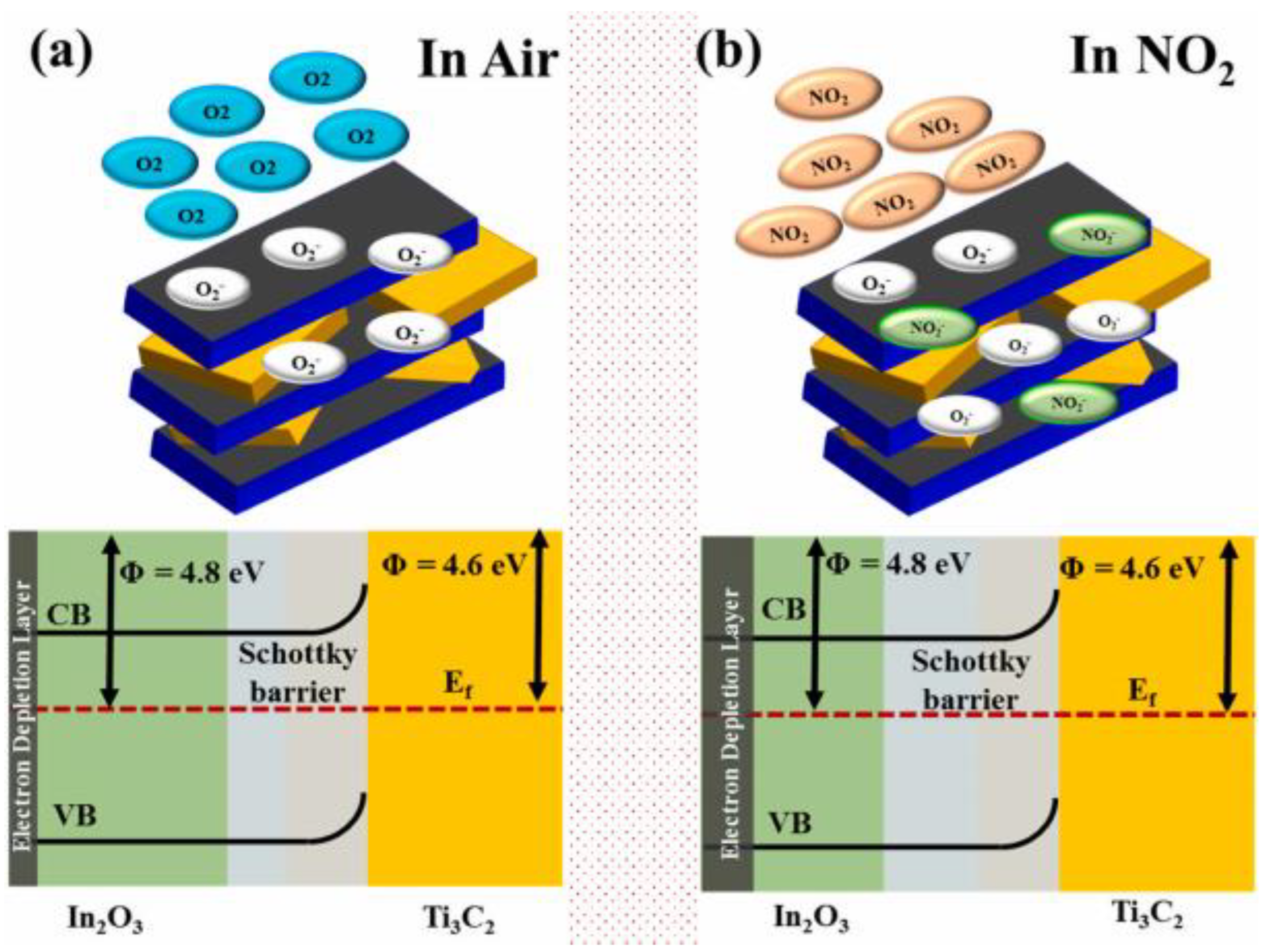

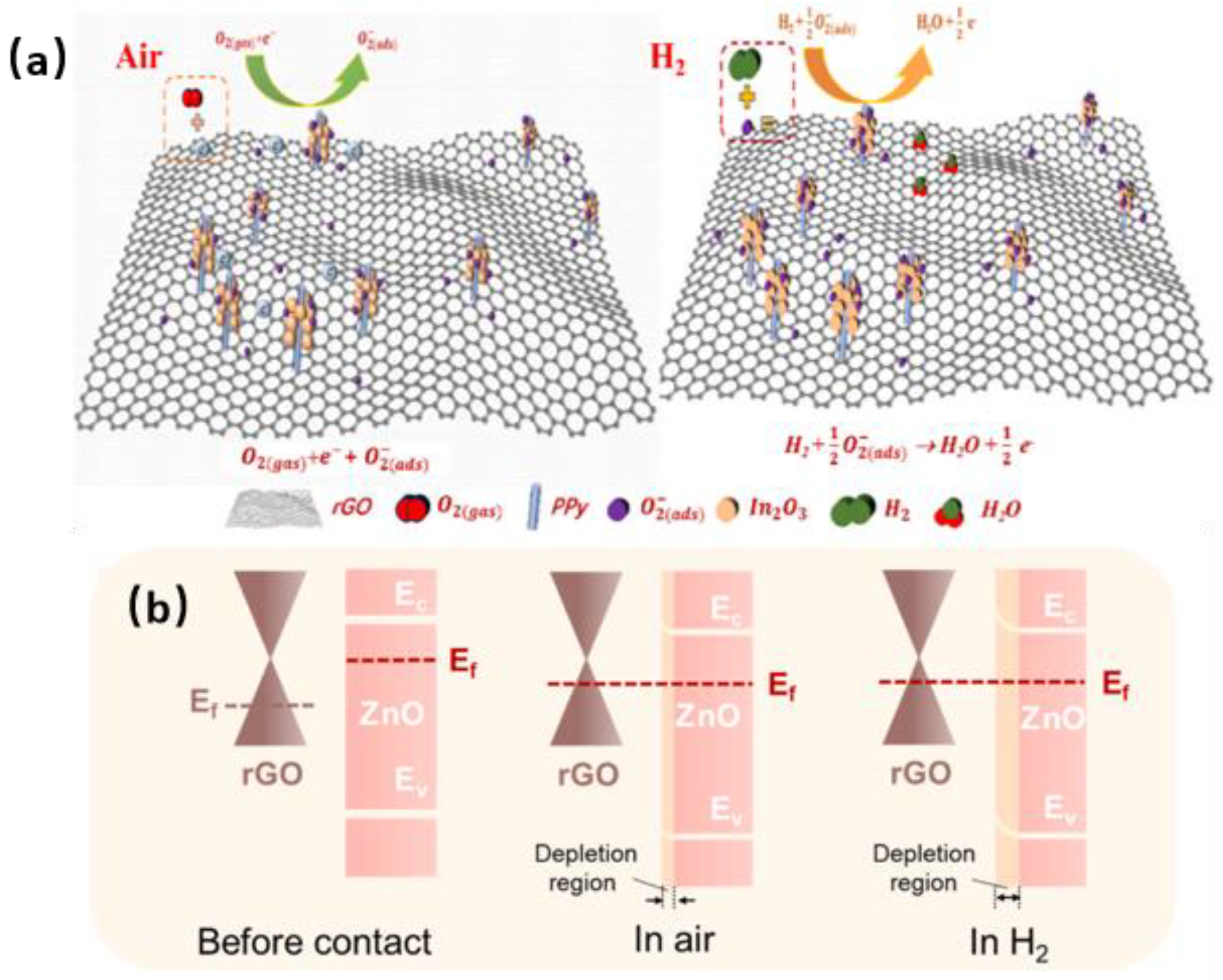
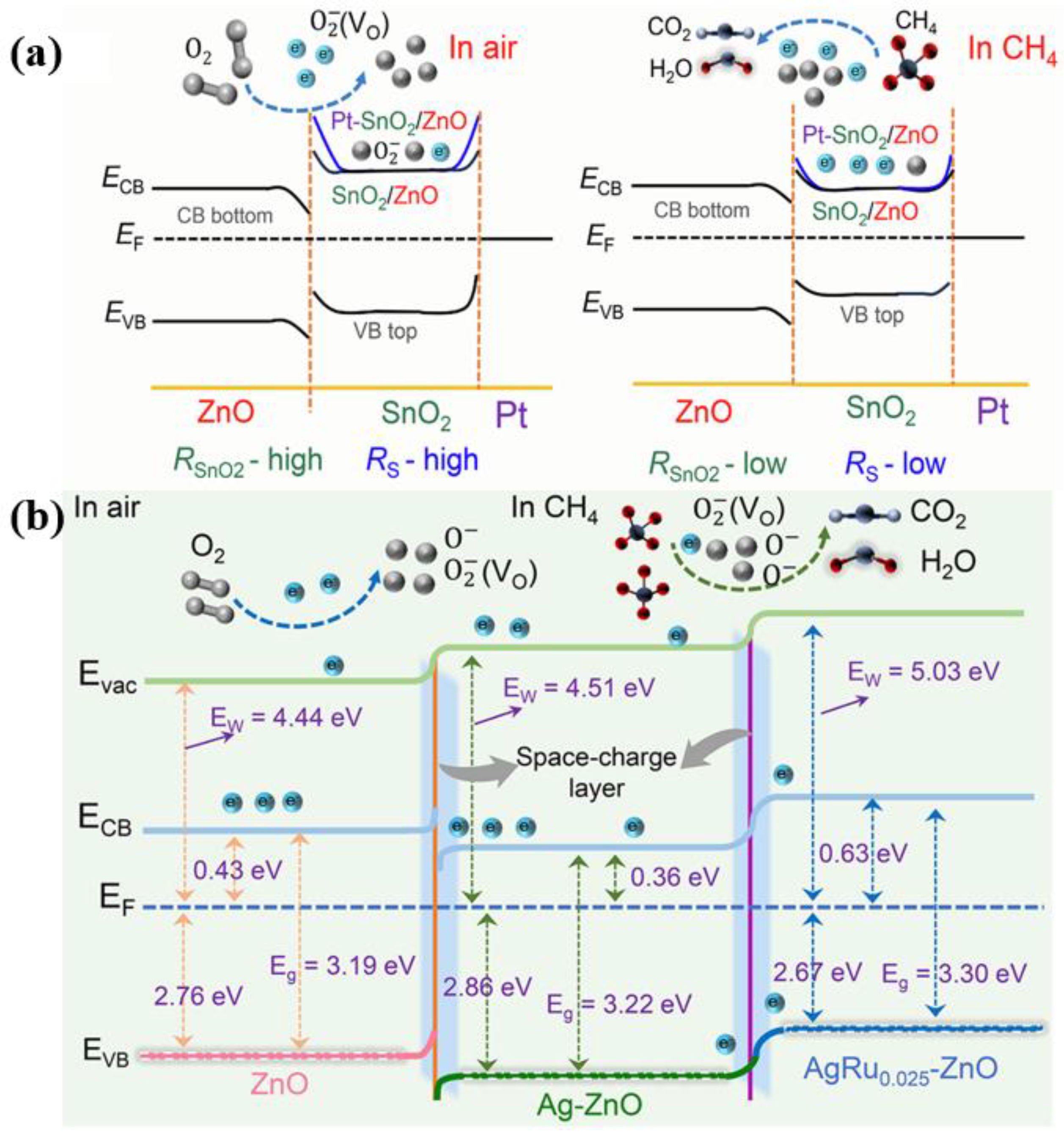


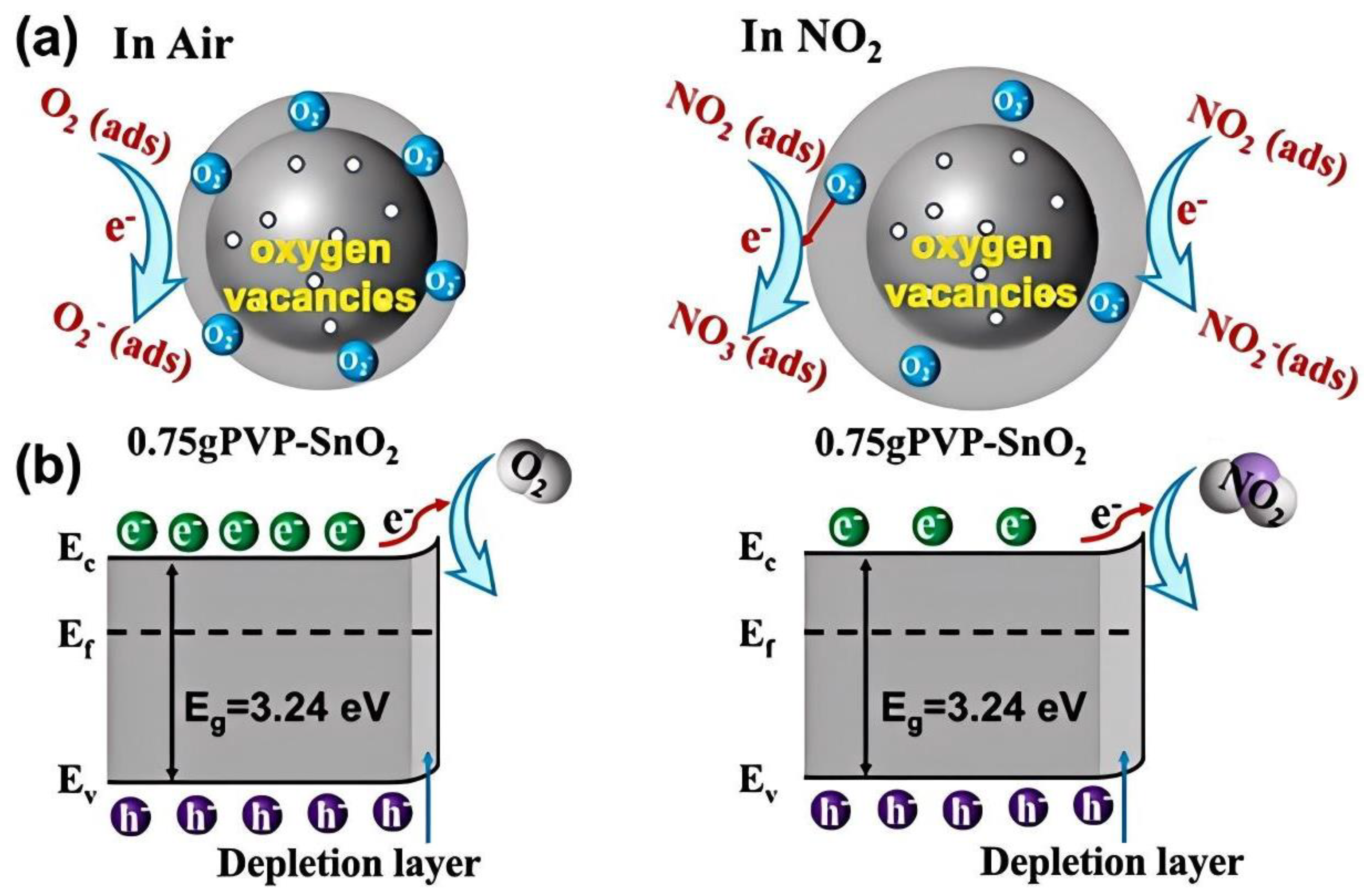

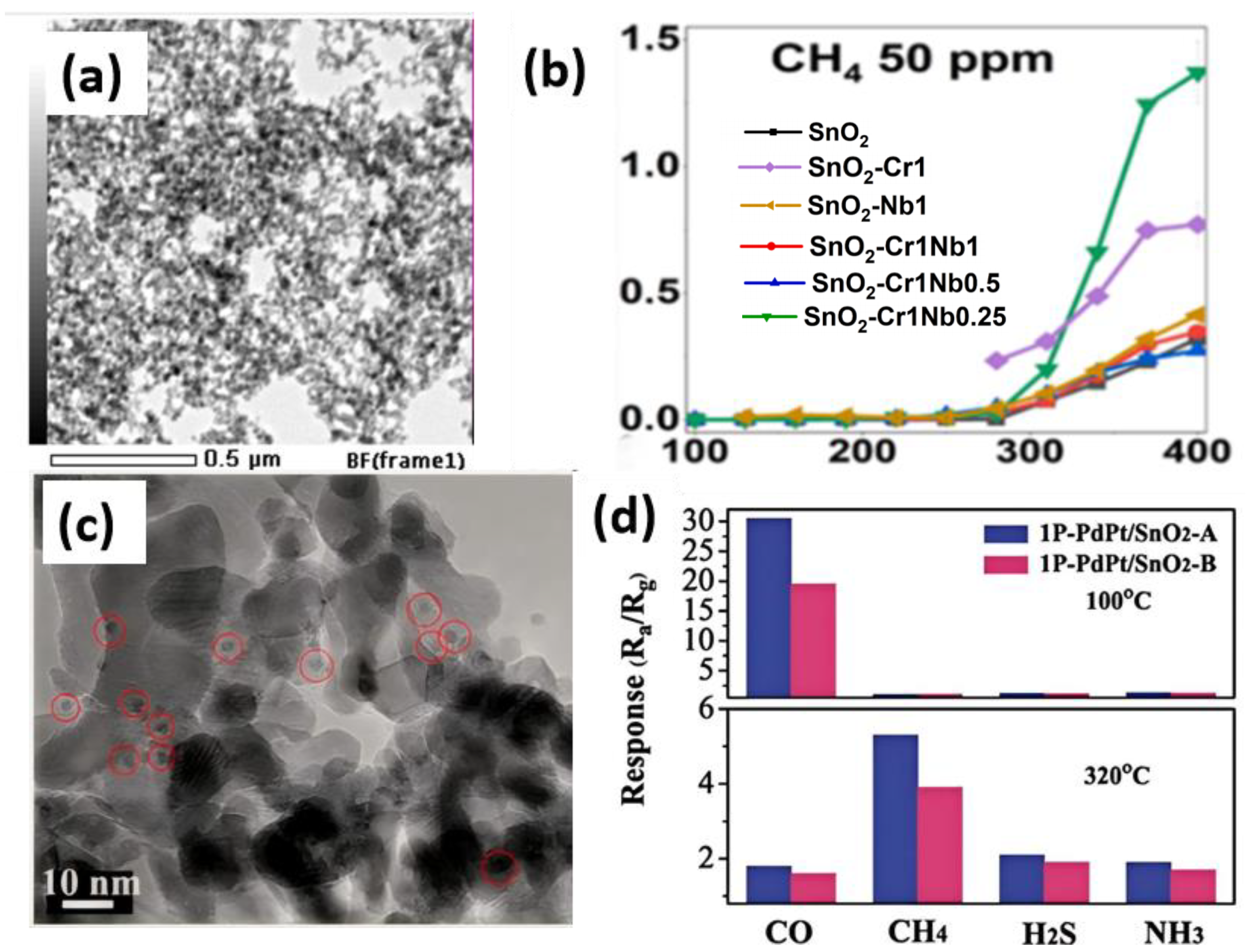
| Sensing Material | Conc. (ppm) | Response Value (Rg/Ra or Ra/Rg) | Response/Recovery Time (s) | Reference |
|---|---|---|---|---|
| Pd/CuO Nanorods/SnSe2 Nanoflower | 200 | 1.53 | 13/58 | [6] |
| 1 wt% Pt/SnO2 nanoceramics | 400 | 2427 | -/- | [7] |
| 0.10Au-decorated ZnO nanosheets | 100 | 139.75 | 61/61 | [8] |
| Au-Loaded WS2/SnO2 | 1 | 12.6 | -/- | [18] |
| MOF-derived SnO2/NiO | 50 | 5.48 | 56/4 | [9] |
| CuO/SnO2 Hollow-Sphere | 300 | 1.40 | -/- | [5] |
| NiO/Ti3C2Tx | 400 | 1.43 | 8/16 | [11] |
| PANI/Ti3AlC2/CeO2 | 500 | 1.17 | 347/- | [19] |
| MWCNTs/SnO2 | 300 | 1.80 | 5/7 | [16] |
| rGO wrapped SnS2 nanosphere | 10 | 10 | 11/10 | [17] |
| Sensing Material | Conc. (ppm) | Response Value (Rg/Ra or Ra/Rg) | Response/Recovery Time (s) | Reference |
|---|---|---|---|---|
| rGO/Bi2S3 | 1 | 9.8 | 22/106 | [23] |
| rGO/CuO | 5 | 11.04 | 10/110 | [24] |
| rGO/CuO nanoflakes | 5 | 1.26 | 6.8/55.1 | [20] |
| vacancies-rich SnO2-RGO | 1 | 5.8 | 95/385 | [25] |
| rGO/In2O3 | 1 | 1177 | 675/559 | [21] |
| 8 wt% GO-mediated In2O3 | 1 | 1021 | 413/182 | [26] |
| In2O3/Ti3C2 nanosheets | 100 | 371.19 | 18/95 | [22] |
| Ti3C2Tx | 10 | 1.14 | -/- | [27] |
| Ti3C2Tx-sphere-like CuO | 50 | 1.57 | 13.5/20.9 | [28] |
| Ti3C2-I | 120 | 1.15 | 90/105 | [29] |
| Ti3C2Tx/WS2 | 1 | 1.15 | -/- | [30] |
| V2CTx/SnS2 | 5 | 2.49 | 4.8/4.7 | [31] |
| MoSe2-WS2 | 0.05 | 1.60 | 68.9/65.7 | [32] |
| GaSe0.58O0.42 | 6 | 7.75 | 48/378 | [33] |
| MoSe2/0.5–Co3O4 | 0.05 | 1.26 | 139/20 | [34] |
| Sensing Material | Conc. (ppm) | Response Value (Rg/Ra or Ra/Rg) | Response/ Recovery Time (s) | Reference |
|---|---|---|---|---|
| MoO3@CoMoO4@CoMoS3.13 | 50 | 35.42 | 1.1/- | [35] |
| Te@Se Core−Shell | 1 | 7.22 | 10/30 | [37] |
| ZnInS4 | 10 | 3.28 | 2/3.7 | [36] |
| Hollow Co3O4 nanocages in NiO cilia | 100 | 47.4 | 1.3/9.6 | [39] |
| UV-activated p-type CuCrO2 | 250 | 3.60 | 107/300 | [40] |
| SnO2 decorated Te nanotubes | 0.6 | 1.33 | 32/109 | [38] |
| Au@In2S3/In2O3 | 100 | 20.7 | 12/27 | [41] |
| Sensing Material | Conc. (ppm) | Response Value (Rg/Ra or Ra/Rg) | Response/Recovery Time (s) | Reference |
|---|---|---|---|---|
| flower-like In2O3/SnS2 | 1000 | 3.43 | -/- | [47] |
| Mace-like In2O3@ZnO microtubules | 10,000 | 6.67 | 178/338 | [48] |
| 5.0Pd@ZnO | 200 | 1.53 | -/- | [49] |
| Pd-Mg alloy thin films | 500 | 1.13 | 85/360 | [50] |
| 3D In2O3@rGO@PPy aerogel | 1000 | 11.6 | 13/29 | [45] |
| Cactus-like ZnO@3D rGA | 10,000 | 81.07 | 15/27 | [46] |
| MoSe2 -WSe2 | 25 | 1.60 | 16/30 | [51] |
| Sensing Material | Conc. (ppm) | Response Value (Rg/Ra or Ra/Rg) | Response/Recovery Time (s) | Reference |
|---|---|---|---|---|
| Pt-SnO2/ZnO | 2000 | 3.73 | 150/147 | [52] |
| In2O3−ZnO/Laser-Induced Graphene | 500 | 1.38 | 48/169 | [53] |
| Ag−Ru Co-doped ZnO Nanorods | 800 | 1.8 | -/- | [54] |
| Mulberry-Like ZnO/SnO2 Hierarchical Structure | 100 | 1.27 | 163/89 | [57] |
| Photo-activated Au-modified ZnO microsphere | 5000 | 4.65 | -/- | [58] |
| UV-activated ZnO spheres | 1000 | 10.18 | 6/134 | [55] |
| UV-activated AuAg/ZnO | 5000 | 62.61 | 5/- | [56] |
| NiO/ZnO | 5000 | 8.61 | 32/182 | [59] |
| MWCNT with MOF (PCN-14) | 50,000 | - | 120/- | [60] |
| MWCNT/Pd | 100 | 1.36 | 20/25 | [61] |
| Sensing Material | Temperature (°C) | Conc. (ppm) | Response Value (Rg/Ra or Ra/Rg) | Response/Recovery Time (s) | Reference |
|---|---|---|---|---|---|
| Au-Co3O4 NPs | 136 | 0.1 | 1.34 | 84/68 | [79] |
| CuO NWs | 110 | 0.5 | 2 | -/- | [80] |
| ZnO nanopowder | 200 | 10 | 41.6 | 41/- | [81] |
| Hierarchically porous ZnO | 190 | 10 | 3.42 | 9/26 | [82] |
| Oxygen-enriched SnO2 NPs | 102 | 0.5 | 14.7 | 45.9/178.2 | [83] |
| Sensing Material | Working Temperature (°C) | Conc. (ppm) | Response Value (Rg/Ra or Ra/Rg) | Response/Recovery Time (s) | Reference |
|---|---|---|---|---|---|
| Pt/Nb-doped TiO2 nanoplate | 40 | 1000 | 12.3 | 30/270 | [84] |
| rGO/Nb-doped TiO2-nanoplate | 100 | 1000 | 2.5 | 32.5/58 | [85] |
| PdNPs@Al2O3 | 200 | 400 | - | 14/10 | [69] |
| oxygen vacancy-enhanced SnO2 | 250 | 6 | 2.3 | 7/12 | [86] |
| Pd-SnO2 nanoflower clusters with F-WO3 microparticles | 300 | 15 | 18.7 | 10/22.5 | [87] |
| Sensing Material | Working Temperature (°C) | Conc. (ppm) | Response Value (Rg/Ra or Ra/Rg) | Response/Recovery Time (s) | Reference |
|---|---|---|---|---|---|
| Nb and Cr-doped SnO2 | 400 | 50 | 3.35 | -/- | [88] |
| Co-doped ZnO nanorods | 50 | 1000 | 1.19 | 350/106 | [89] |
| PdPt/SnO2 | 320 | 1000 | 5.2 | -/- | [90] |
| 7.5 at% Pt-SnO2 thin-film | 430 | 12,500 | - | -/- | [91] |
Disclaimer/Publisher’s Note: The statements, opinions and data contained in all publications are solely those of the individual author(s) and contributor(s) and not of MDPI and/or the editor(s). MDPI and/or the editor(s) disclaim responsibility for any injury to people or property resulting from any ideas, methods, instructions or products referred to in the content. |
© 2025 by the authors. Licensee MDPI, Basel, Switzerland. This article is an open access article distributed under the terms and conditions of the Creative Commons Attribution (CC BY) license (https://creativecommons.org/licenses/by/4.0/).
Share and Cite
Zhang, Y.; Li, R.; Guo, R.; Jiao, M.; Wang, G.; Zhao, Z. Recent Progress in Low-Power-Consumption Metal Oxide Semiconductor Gas Sensors. Materials 2025, 18, 4864. https://doi.org/10.3390/ma18214864
Zhang Y, Li R, Guo R, Jiao M, Wang G, Zhao Z. Recent Progress in Low-Power-Consumption Metal Oxide Semiconductor Gas Sensors. Materials. 2025; 18(21):4864. https://doi.org/10.3390/ma18214864
Chicago/Turabian StyleZhang, Yu, Renbo Li, Ruqi Guo, Mingzhi Jiao, Gang Wang, and Zhikai Zhao. 2025. "Recent Progress in Low-Power-Consumption Metal Oxide Semiconductor Gas Sensors" Materials 18, no. 21: 4864. https://doi.org/10.3390/ma18214864
APA StyleZhang, Y., Li, R., Guo, R., Jiao, M., Wang, G., & Zhao, Z. (2025). Recent Progress in Low-Power-Consumption Metal Oxide Semiconductor Gas Sensors. Materials, 18(21), 4864. https://doi.org/10.3390/ma18214864








